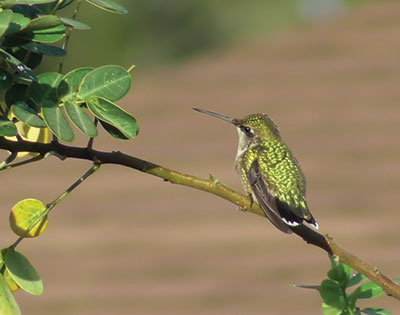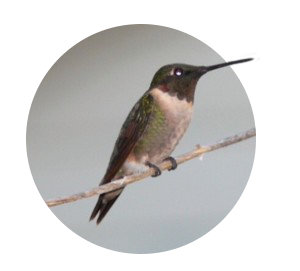While some Floridians may never see a hummingbird, Steve Backes almost always has them in his Valrico yard. A female rufous is above; lower left is a young male Ruby-throated. All Photos by Steve Backes.[/su_pullquote]
If we’re lucky enough to have had it happen, most Floridians clearly remember the first time we saw a hummingbird. These amazing creatures – weighing as little as a quarter-ounce but requiring nearly half their weight in food every day – can hover over flowers, flit backward to a more enticing bloom and even fly upside down to reach an elusive drop of nectar.
Although relatively rare in Florida, up to 11 of the 16 species of hummingbirds found in the U.S. have been seen in the state. You’re most like to see the ruby-throated hummingbird, but black-chinned and rufous are occasional visitors with buff-bellied, calliope and Allen’s all recorded in the Tampa Bay region. They begin returning from more northern climes as temperatures drop, and many appear to return to the same backyard year after year, particularly those habitats that have been planted with hummingbirds in mind.
 Steve Backes sees hummingbirds in his suburban Valrico yard so often that nationally renowned hummingbird expert Fred Bassett visits most winters to band and document the “snow birds” who come south to Alabama and Florida. “It’s really cool because without the bands you have to guess if it’s the same bird,” Backes said. “With banded birds, you know they’ve come back.”
Steve Backes sees hummingbirds in his suburban Valrico yard so often that nationally renowned hummingbird expert Fred Bassett visits most winters to band and document the “snow birds” who come south to Alabama and Florida. “It’s really cool because without the bands you have to guess if it’s the same bird,” Backes said. “With banded birds, you know they’ve come back.”
The trick to attracting hummingbirds, he says, is planting plenty of their favorite foods – including lots of red flowers – and hanging feeders. “It’s really difficult for them to get enough food from flowers but they need to see the flowers to decide to check out your yard and find the feeders.”
Backes has an amazing selection of plants in his yard, interspersed with feeders protected from ants that also love sugar water. The feeders also need to be visually separated from each other because hummingbirds can be very territorial. (Other feeders, dispensing treats ranging from standard bird food to mealworms he grows in his kitchen for bluebirds that nest nearby, can be closer to the hummingbird feeders, though.)
Some birds overwinter here, beginning in late September, but others will stay long enough to nest, usually beginning in about April. It’s more challenging to create their favorite habitat for nests because they prefer trees over running water, but they will travel to a nearby yard to obtain food.
Backes’ favorite plants for hummingbirds are also likely to attract butterflies so even a small amount of land set aside for them is beneficial even after the hummingbirds have left for the summer. Most are easy to grow – so easy, in fact, that he regularly hosts “clean-up” days at his home where you can help prune plants and take home cuttings or rooted pieces that have spread from the original plant.
Learn more about hummingbirds in Florida – including sightings from across the state and insights from experts into the most effective plants – at Backes’ Facebook page.

Some of Backe’s favorite plants for hummingbirds
Native red salvia as well as other salvias that might be easier to find in “big box” stores.
Firebush (Hamelia patens), a Florida native that can become large but is easily cut back to a more manageable size in a small yard. You can’t count on it to bloom if we get temperatures below freezing but it will come back from the ground after a cold event. They grow from cuttings or the seeds in their berries if the birds don’t get to them first.
Firecracker (Cuphea), also called cigar flower, is another plant that blooms all winter as long as it doesn’t drop below freezing.
Porterweed (Stachytarpheta jamaicensis), particularly the non-native pink or red varieties, although hummingbirds will nectar on the low-growing native porterweed once they discover it.
Flowering maple (Abutilion) isn’t really a maple, it’s related to cotton, hibiscus, and okra. Although it’s a frost-sensitive non-native, it’s still one of Backes’ favorites because it attracts so many hummingbirds with its winter flowers.
Coral honeysuckle (Lonicera sempervirens), a native vine that quickly covers a trellis or fence and can also be used as a groundcover. Butterflies and hummingbirds nectar on brilliant red flowers and birds eat the berries that follow them.
Powder puff trees (Calliandra haematocephala) are small trees or large shrubs with distinctive “powder puff” flowers in red, pink and white that attract a wide variety of pollinators plus hummingbirds.
Firespike (Odontonema strictum) is most well-known for its red flowers although Backes grows them in different colors that bloom at different times of the year.
Necklace pod (Sophora tomentosa), a native shrub with yellow flowers and distinctive seed pods that resemble a string of pearls.
Shrimp plants (Justicia brandegeana) come in a wide variety of colors including red, yellow, pink and even a “fruit cocktail” with multiple colors on the same plant.
By Vicki Parsons, originally published Fall 2016
